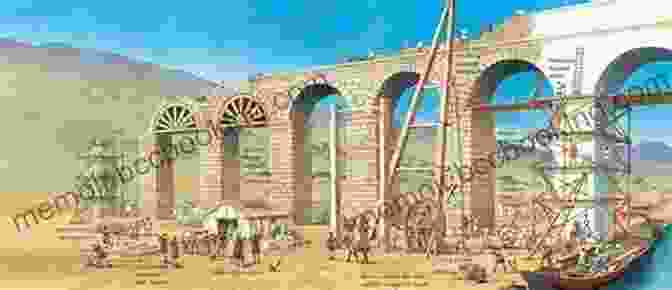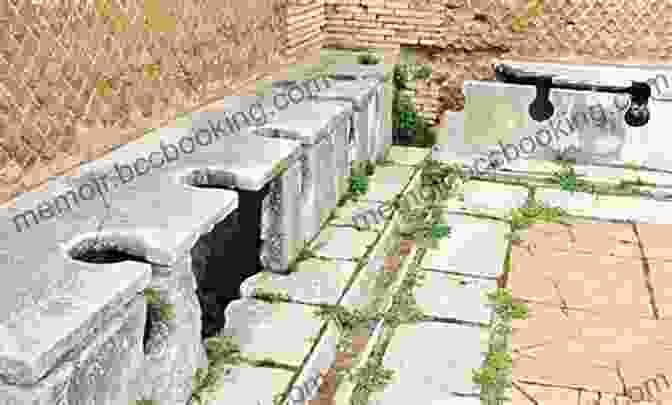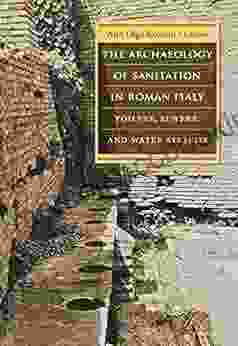Unveiling the Secrets of Ancient Roman Sanitation: A Journey through "The Archaeology of Sanitation in Roman Italy"

Step back in time to the bustling streets of ancient Rome, a city teeming with over a million inhabitants. Amidst the grandeur of temples, palaces, and amphitheaters, there existed a sophisticated system of sanitation that shaped the daily lives of its citizens. In the groundbreaking work "The Archaeology of Sanitation in Roman Italy," renowned archaeologist and environmental historian C. Michael Hogan delves into the fascinating world of Roman sanitation, revealing the intricate systems, hygienic innovations, and social implications that defined this remarkable society. 4.9 out of 5 Through meticulous archaeological research and captivating storytelling, Hogan paints a vivid picture of the Roman approach to public health and environmental management. From the construction of vast aqueducts that brought fresh water to every corner of the city to the development of elaborate latrines and public baths, the Romans demonstrated an extraordinary understanding of the importance of hygiene and sanitation. This article embarks on a journey through the pages of "The Archaeology of Sanitation in Roman Italy," exploring the key discoveries and insights that have transformed our understanding of ancient Roman sanitation. Water was the lifeblood of Roman cities, and the Romans invested heavily in ensuring a reliable and abundant supply. They constructed an extensive network of aqueducts, some stretching for hundreds of kilometers, that transported water from distant springs and rivers into the heart of Rome. These aqueducts were engineering marvels, with sophisticated systems of filtration and distribution that ensured a constant flow of clean water to households, public baths, and fountains. The Romans also constructed an abundance of fountains throughout the city, providing easy access to clean drinking water for all citizens. These fountains often served as social gathering places, where people could meet, exchange news, and conduct business. The presence of abundant clean water not only improved the health and well-being of the population but also fostered a sense of community and civic pride. The Romans recognized the importance of proper waste disposal for maintaining public health and preventing disease outbreaks. They developed a sophisticated system of latrines, both public and private, that efficiently removed human waste from the city. These latrines were typically located in public buildings, markets, and insulae (multi-story apartment buildings). They consisted of rows of stone or marble seats with running water that flushed the waste into a central sewer system. The centerpiece of the Roman sewer system was the Cloaca Maxima, a vast underground channel that collected wastewater from all parts of the city and discharged it into the Tiber River. The Cloaca Maxima was a remarkable feat of engineering, constructed using massive stone blocks and capable of carrying immense volumes of wastewater. It remains a testament to the Romans' commitment to public sanitation and their ingenuity in solving complex environmental challenges. Public baths played a central role in Roman society, serving both as places for personal hygiene and social gatherings. The Romans constructed elaborate bath complexes, or thermae, throughout the city, providing access to hot, warm, and cold baths for all citizens. These thermae were often adorned with beautiful mosaics, sculptures, and fountains, creating a luxurious and inviting atmosphere. Bathing was an integral part of Roman daily life, and the thermae provided a vital space for relaxation, socialization, and physical exercise. Romans would spend hours bathing, socializing, and engaging in various forms of entertainment, such as playing games, reading, and listening to music. The thermae also served as important social hubs, where people from all walks of life could interact and discuss the latest news and events. The Roman approach to sanitation had a profound impact on society and the environment. The provision of clean water and efficient waste disposal systems significantly reduced the incidence of waterborne diseases and improved the overall health and well-being of the population. The construction of public baths promoted personal hygiene and provided a space for social interaction, fostering a sense of community and civic pride. However, the Roman sanitation system was not without its environmental challenges. The vast network of aqueducts and sewers required significant resources to build and maintain, and the use of lead pipes for water distribution posed health risks to the population. Additionally, the discharge of wastewater into the Tiber River contributed to pollution and environmental degradation. The Roman sanitation system remains a testament to the ingenuity and foresight of the ancient Romans. Their advancements in water management, waste disposal, and public hygiene have had a lasting impact on urban sanitation practices around the world. Many modern water and sewer systems are modeled on the principles established by the Romans, and the concept of public baths continues to inspire modern-day spas and wellness centers. The study of Roman sanitation, as exemplified in "The Archaeology of Sanitation in Roman Italy," provides valuable insights into the development of public health and environmental management. By understanding the successes and challenges of the Roman sanitation system, we can gain valuable lessons for addressing contemporary issues related to water scarcity, pollution, and sustainable urban development. "The Archaeology of Sanitation in Roman Italy" is a groundbreaking work that unveils the intricate world of ancient Roman sanitation. Through meticulous archaeological research and captivating storytelling, C. Michael Hogan paints a vivid picture of the systems, innovations, and social implications that shaped sanitation practices in the Roman Empire. By exploring the book's key discoveries and insights, we gain a deeper appreciation for the remarkable advancements made by the Romans in ensuring the health, well-being, and environmental sustainability of their cities. The legacy of Roman sanitation continues to inspire and inform modern-day sanitation practices, demonstrating the enduring value of studying past societies to address contemporary challenges. "The Archaeology of Sanitation in Roman Italy" is a must-read for anyone interested in ancient history, public health, environmental management, or the evolution of human civilization.Language : English File size : 26874 KB Text-to-Speech : Enabled Screen Reader : Supported Enhanced typesetting : Enabled Print length : 307 pages The Water Supply: Aqueducts and Fountains

Waste Disposal: Latrines and Cloaca Maxima

Public Baths: A Haven for Hygiene and Social Interaction

Social and Environmental Implications
Legacy and Influence
4.9 out of 5
| Language | : | English |
| File size | : | 26874 KB |
| Text-to-Speech | : | Enabled |
| Screen Reader | : | Supported |
| Enhanced typesetting | : | Enabled |
| Print length | : | 307 pages |
Do you want to contribute by writing guest posts on this blog?
Please contact us and send us a resume of previous articles that you have written.
 Book
Book Novel
Novel Page
Page Chapter
Chapter Text
Text Story
Story Genre
Genre Reader
Reader Library
Library Paperback
Paperback E-book
E-book Magazine
Magazine Newspaper
Newspaper Paragraph
Paragraph Sentence
Sentence Bookmark
Bookmark Shelf
Shelf Glossary
Glossary Bibliography
Bibliography Foreword
Foreword Preface
Preface Synopsis
Synopsis Annotation
Annotation Footnote
Footnote Manuscript
Manuscript Scroll
Scroll Codex
Codex Tome
Tome Bestseller
Bestseller Classics
Classics Library card
Library card Narrative
Narrative Biography
Biography Autobiography
Autobiography Memoir
Memoir Reference
Reference Encyclopedia
Encyclopedia Barbara Garrett
Barbara Garrett Amara Charles
Amara Charles Barb Asselin
Barb Asselin Ann Marie Brown
Ann Marie Brown Annie Boochever
Annie Boochever Annette Carson
Annette Carson Anna Leinberger
Anna Leinberger Arden Moore
Arden Moore Bailey Gaddis
Bailey Gaddis Ari D
Ari D Antonia Felix
Antonia Felix Anne Strathie
Anne Strathie Anna Kaminski
Anna Kaminski Anna Reid
Anna Reid Auberon Harte
Auberon Harte Anna Kopp
Anna Kopp Aram Attarian
Aram Attarian Ariana Dimitrakis
Ariana Dimitrakis Annie Jacobsen
Annie Jacobsen Anne Aly
Anne Aly
Light bulbAdvertise smarter! Our strategic ad space ensures maximum exposure. Reserve your spot today!

 Hamilton BellDiscover the Exciting World of Counting with "Can Learn To Count Some More...
Hamilton BellDiscover the Exciting World of Counting with "Can Learn To Count Some More... José SaramagoFollow ·3.5k
José SaramagoFollow ·3.5k Kenneth ParkerFollow ·8k
Kenneth ParkerFollow ·8k Shawn ReedFollow ·7.9k
Shawn ReedFollow ·7.9k Deacon BellFollow ·2.6k
Deacon BellFollow ·2.6k Jeffery BellFollow ·13.7k
Jeffery BellFollow ·13.7k George HayesFollow ·4.1k
George HayesFollow ·4.1k Fletcher MitchellFollow ·12.7k
Fletcher MitchellFollow ·12.7k Dean ButlerFollow ·2.6k
Dean ButlerFollow ·2.6k

 Brayden Reed
Brayden ReedTeach Your Child They Have No Self Worth And They Will...
By Dr. Jane Doe ...

 Shawn Reed
Shawn ReedUnveiling Centuries of Tradition: History of Childbirth...
Journey into the heart of the...

 Brady Mitchell
Brady MitchellProven Guidelines For Healthy Multiple Pregnancy
Congratulations on your...

 Dylan Mitchell
Dylan MitchellHarness the Power of Sleep for Optimal Health and...
In the fast-paced,...

 Herman Melville
Herman MelvilleAlexander Hamilton: The Revolutionary Who Shaped...
Alexander Hamilton was a...
4.9 out of 5
| Language | : | English |
| File size | : | 26874 KB |
| Text-to-Speech | : | Enabled |
| Screen Reader | : | Supported |
| Enhanced typesetting | : | Enabled |
| Print length | : | 307 pages |












